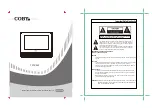
ORIGINAL INSTRUCTIONS > EN
NOTE:
When the battery switch is in the
“
ON
”
position, the switch will light up if the battery is sending
out a charge. If the switch does not light up while in the
“
ON
”
position, check that the battery connection
is still good.
NOTE:
The supplied 12V battery does re-charge while the engine is running, but it is also recommended
that the battery be fully charged at least once per month.
Connecting Electrical Loads
1. Let the engine stabilize and warm up for a few minutes after starting
2. Plug in and turn on the desired 220
—
240 Volt AC single phase, 50 Hz electrical loads.
—
DO NOT connect 3-phase loads to the generator.
—
DO NOT connect 60 Hz loads to the generator.
—
DO NOT overload the generator.
NOTE:
Connecting a generator to your electric utility company’s power lines or to another power source may be
against the law. In addition this action, if done incorrectly, could damage your generator and appliances
and could cause serious injury or even death to you or a utility worker who may be working on nearby
power lines. If you plan to run a portable electric generator during an outage, please notify your electric
utility company immediately and remember to plug your appliances directly into the generator. Do not plug
the generator into any electric outlet in your home. Doing so could create a connection to the utility
company power lines. You are responsible for ensuring that your generator’s electricity does not feed back
into the electric utility power lines.
If the generator will be connected to a building electrical system, consult your local utility company or a
qualified electrician. Connections must isolate generator power from utility power and must comply with all
applicable laws and codes.
Do Not Overload Generator Capacity
Follow these simple steps to calculate the running and starting watts necessary for your purposes.
1. Select the electrical devices you plan on running at the same time.
2. Total the running watts of these items. This is the amount of power you need to keep your items running.
3. Identify the highest starting wattage of all devices identified in step 1. Add this number to the number
calculated in step 2. Surge wattage is the extra burst of power needed to start some electric driven
equipment. Following the steps listed under
‘
Power Management
”
will guarantee that only one device
will be starting at a time.
Power Management
Use the following formula to convert voltage and amperage to watts: Volts x Amps = Watts
To prolong the life of your generator and attached devices, follow these steps to add electrical load:
1. Start the generator with no electrical load attached
2. Allow the engine to run for several minutes to stabilize.
3. Plug in and turn on the first item. It is best to attach the item with the largest load first.
4. Allow the engine to stabilize.
5. Plug in and turn on the next item.
6. Allow the engine to stabilize.
7. Repeat steps 5
—
6 for each additional item.
NOTE:
Never exceed the specified capacity when adding loads to the generator.
NOTE:
Observing frost on LPG(
with Propane
) containers and regulators is common during operation and
normally is not an indication of a problem. As LPG(
with Propane
) vaporizes and travels from the tank to
the generator engine it expands. The amount of frost that forms can be affected by the size of the container,
the amount of fuel being used, the humidity of the air and other operating conditions. In unusual situations
this frost may eventually restrict the flow of gas to the generator resulting in deteriorating performance. For
example, if the tank temperature is reduced to a very low level then the rate at which the LPG(
with
Propane
) vaporizes is also reduced and may not provide sufficient fuel flow to the engine. This is not an
16











































